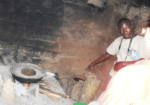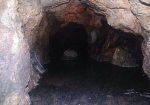Kibiro salt processing village is located along the eastern shore of lake Albert about 22 km from Hoima town. Archaeological evidence suggests that salt-making at Kibiro, has been practiced for about 700–800 years.
Kibiro salt producing has sustained the people around for more than 700 years and continues to do so perhaps for posterity from fishing on Lake Albert, they depend on production of ash salt which is obtained by recycling residual earth with fresh soil which is spread on salt gardens for the salty water to get absorbed by capillary system. Through repeated scraping, spreading and heaping of the salty soil over a seven days period, it is leached and the scam is boiled to crystallization point to produce the ash salt. The residual soil from leaching is then mixed with fresh soil to repeat the salt production process. Before the introduction of metallic vessels, pottery ware was used during the leaching and boiling processes and this is evidenced by the rich archaeological depositions of potsherds throughout the village going as deep as 4 meters.
There are different roles that are distributed to different groups where the women are for salt production and the men for fishing. Besides the salt deposits at Kibiro, there is the oldest grinding groove on the large boulder above the hot springs at Mukihanga where the locals perform rituals on scared pools at Mukamira and Mutebere. According to the locals even human sacrifices used to be performed.













1 Comment
yoweri A, 2018-02-22 at 8:24 AM
wonderful site i must say